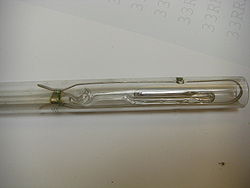
Reversing thermometer
Encyclopedia

Mercury (element)
Mercury is a chemical element with the symbol Hg and atomic number 80. It is also known as quicksilver or hydrargyrum...
thermometers, a reversing thermometer is able to record a given temperature
Temperature
Temperature is a physical property of matter that quantitatively expresses the common notions of hot and cold. Objects of low temperature are cold, while various degrees of higher temperatures are referred to as warm or hot...
to be viewed at a later time. If the thermometer is flipped upside down, the current temperature will be shown until it is turned upright again. This was the primary device used by oceanographers
Oceanography
Oceanography , also called oceanology or marine science, is the branch of Earth science that studies the ocean...
to determine water temperatures below the surface of the ocean from around 1900 to 1970.
It consists of a conventional bulb connected to a capillary in which a constriction is placed so that upon reversal the mercury column breaks off in a reproducible manner. The mercury runs down into a smaller bulb at the other end of the capillary, which is graduated to read temperature. A 360° turn in a locally widened portion of the capillary serves as a trap to prevent further addition of mercury if the thermometer is warmed and the mercury expands past the break-off point. The remote-reading potentialities of reversing thermometers make them particularly suitable for use in measuring subsea temperature as a function of pressure. In this application, both protected thermometers and unprotected thermometers are used, each of which is provided with an auxiliary thermometer. They are generally used in pairs in Nansen bottle
Nansen bottle
A Nansen bottle is a device for obtaining samples of seawater at a specific depth. It was designed in 1910 by the early 20th-century explorer and oceanographer Fridtjof Nansen and further developed by Shale Niskin....
s. They are usually read to 0.01°C, and after the proper corrections have been applied, their readings are considered reliable to 0.02°C.
External links
- Introduction to Physical Oceanography by Robert H. Stewart (Open Source Textbook)
- Glossary of Meteorology (American Meteorological Society)

